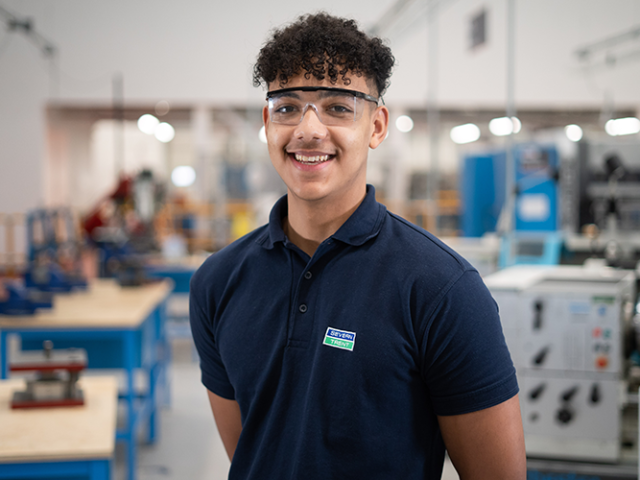David Winch is a STEM advocate making strides in improving the STEM landscape. Having grown up with an interest and confidence with numbers, and thanks to doing and making things since a child, David has always had an interest in science, technology, engineering and maths. Read on to hear about David’s fascination with STEM from an early stage, and how it kickstarted his career.
For as long as I can remember, and I have a very long memory going right back to the late Queen’s Coronation, I have been comfortable with numbers. Before I ever started school, which was just after my fifth birthday, I was able to count to a hundred and I understood basic addition to the extent of ‘three and three makes six’ and ‘two and five makes seven’. I remember coming home from my first day in Reception Class and telling my Mum that I’d learned two new letters – “+” means ‘and’ and “=” means ‘makes’, I proudly told her! My comfort was evolving into fascination.
Where, then, might this comfort have come from? For one thing, my parents had always encouraged me to join in with nursery rhymes, and those with numbers like “One, two, three-four-five, once I caught a fish alive” were as popular as “Jack and Jill went up the hill” and “Mary had a little lamb”.
Mine was also a very practical family. My parents had met when they both worked as Post Office Counter Clerks, so they were adept and accurate with numbers and arithmetic. At home, my Mum was a keen cook, knitter and dressmaker, while my Dad loved gardening and carpentry. In all of these activities, they brought out the ‘numbers’ and ‘working it out’ side of everything and encouraged me to understand what was going on.
Essentially, my whole close family encouraged ‘doing’ and ‘learning’ as being things one should want to be good at.
It’s probably unsurprising that I grew familiar and comfortable with numbers, and developed a practical bent too – always wanting to take things (construction toys and other things) apart to see how they worked, but often needing help to put them back together again afterwards, at least in my very young days. Around the age of three I was given a clockwork train set. The track wasn’t screwed down so I had to assemble the straights, curves and points each time and put it all away tidily afterwards.
For my sixth birthday, I was given a tenon saw, a sawing block, a small block plane, a carpenter’s folding wooden rule and a carpenter’s pencil, with its rectangular lead. To go with these presents, my Mum made me my own carpenter’s apron! A couple of months after my birthday I received another present. My Mum gave birth to my little sister and, as she grew up in a very similar environment, she developed an equal love of numbers, even if her practical fascination was more with cooking, knitting and sewing. It was another year or two before I was given my first Meccano set, although I did have a plastic construction toy before my sister was born.
As I got further through school, by Top Infants (Year 2) we were dealing with different measuring and counting systems as well as pure numbers – pounds and ounces, and pounds, shillings and pence – and being able to do subtraction as well as addition sums where you had to carry, borrow and pay back. We never realised that what we were doing was counting in many different bases; we just took it all in our stride.
In Junior School (Years 3 to 6) we learned about multiplication and division and how to perform long multiplication and long division, as well as decimals, percentages, areas and scaled maps. My fascination broadened to include mathematics as well as just numbers. Right from Year 3 we covered not just ‘arithmetic’ but also ‘problems’ where you had to set up the equation from the information in the question and then solve it, and ‘mental’ where the only thing you were allowed to write down was the answer to the arithmetic question. By Year 6 we were also studying geometry and the basics of technical drawing, as we had to create our own designs for ‘fold-up’ houses and other buildings, whose various surfaces had to fit together, for example the roof over the gable ends, when we cut them out and glued them together.
Meanwhile, when I was in Year 3 I think, my little sister was given a second-hand dolls’ house which had lights (torch bulbs) in each room, with a switch at the back to turn them on and off. She wasn’t interested in the lights so I unscrewed the bulbs and removed the sockets, and decided I could put them to good use at some point. At this time my parents didn’t own a television but my Grandparents did, and one of the joys of dropping in on them after school a couple of times a week, was the chance to watch Children’s TV for half an hour. There were already two television channels by this time so I decided I could make a device with these dolls’ house lights to let my Grandparents know which channel I’d like to watch.
With my woodworking tools and skills, I made a small box and mounted two sockets and bulbs, plus the switch on it, and used some of my pocket money to buy a battery. I connected everything up but neither of the lights worked! I showed it to my Dad when he came in from work and he pointed out that electricity has to flow round a circuit. After I connected the final wire to the other terminal of the battery, everything was fine! Another huge moment in my career as it turned out!
Two other things happened around this time that I think helped shape, possibly ‘cement’, my later life – one at school and one at home. At school, the Headmaster decided to introduce Science lessons for Year 3 in the Summer Term, and we looked at electricity (similar to my ‘box of tricks’), magnets – complete with iron filings to show field lines, electromagnets (with more iron filings) and a toy, working steam engine with its methylated spirit burner. My friends and I were fascinated.
This was typical of the peer group I went through Junior School with. We all had an extreme thirst for knowledge and would do everything we could to acquire more and more facts to commit to memory about all sorts of subjects; not just from books – although Encyclopaedias were my preferred bedtime reading – but also from the cards that came with chewing and bubble gum, as well as those in packets of tea. There was never any antipathy towards ‘nerdy swots’; far from it. Such knowledge (I guess these days we’d call it something like ‘trivia quiz knowledge’) was a goal all aspired to, yet no-one was ever looked down on for being less able than the best. Several years later I learned that the Science lessons were the Headmaster’s reaction to pressure from us pupils to be taught more about science!
Secondly, I got a book out of our local library that contained instructions for making some simple electrical ‘toys’ out of screws, wires, bits cut from a tin can, and some batteries – an electric bell/buzzer and a morse key are two that I can remember as I only made these two things. The local library were able to tell me that the book I’d borrowed was the first of a series of three, so I borrowed the others too. I was hooked – Science was the thing for me!
My family were also avid card players; again great for growing the numeracy skills of young players. Nothing as serious as poker, though the men folk might occasionally play three-card brag for coppers, and we’d all play Chase the Ace for three-ha’pence maximum loss, betting a ha’penny a time, plus whist, patience and the real ‘hooker’, cribbage – a game I still love and which my Grandad assured me “Learns yer to count!” Also, usually at Christmas, the dart board would be brought out and mental subtraction skills would get honed when you kept score with chalk on a blackboard!
At secondary school (Years 7 to, in my case, 14 – I stayed on one term after ‘A’ Levels to take the Cambridge Entrance Exams), although we were introduced to algebra, a much more formal outlook on geometry, and more robust technical drawing in Year 7, I was dismayed to discover we wouldn’t study Science until Year 8. As we approached Year 9, we had to decide whether to specialise in Modern Languages and History, Classical Languages, or Science to go with the compulsory Maths, English, French and Latin – Unsurprisingly I chose Science!
In Maths in Year 11, we were introduced to trigonometry and calculus, and it was finding practical uses for these branches of the subject, particularly for calculus at that time, that fanned the flames of my interest in STEM into the beginnings of an inferno. My Dad had a greenhouse with a water butt in one corner, and he wanted to build a channel to carry water to other parts of the greenhouse. He was going to make it by bending a sheet of galvanised steel to create two side-walls and a floor and he wanted to know how to bend it get the greatest cross-sectional area. It was obvious that, if he made the side-walls one millimetre high, the area would be small. Similarly, if he’d made the floor one millimetre wide the area would be small too. So where between those extremes was the best answer? He could evaluate various ideas, but did I know how to work out exactly how to achieve the maximum cross-sectional area. Well, yes I did as we’d been taught that very week about minima and maxima occurring when the differential is zero!
The structure of my school career may sound odd to modern ears but was sensible in my school at the time. Because we scientists would be taking Physics and Chemistry at ‘A’ Level it was decided we didn’t need to take them at ‘O’ Level. However, Maths ‘O’ Level being such a vital ‘box’ to tick, we would take Maths and Additional Maths, along with English, French and Latin, at ‘O’ Level at the end of Year 10, then embark on a three year ‘A’ Level course in Physics and Chemistry to take the exams at the end of Year 13 like everyone else, but we would take Maths ‘A’ Level at the end of Year 12!
As I entered the Sixth Form (Year 11 in my case!) a young Maths teacher, newly out of University, arrived at the school and asked the Headmaster if he could introduce a new ‘optional’ subject for sixth formers – Computer Programming. I remember thinking that computers could well be the up and coming thing, so I jumped at it.
In the first term he taught us the ‘new maths’ we needed – sets, cups and caps, Venn diagrams, logic gates, truth tables, Boolean Algebra, and how Boolean expressions could be modelled as switches. One practical use I spotted for this knowledge was the ability to solve the weekly New Scientist ‘Brain Teaser’ using algebra! After a trip to the school library, I discovered that Lewis Carroll, author of Alice in Wonderland and Alice Through the Looking Glass, was also a Maths Don at Oxford and, under his real name of Charles Dodgson, had published an entire book of similar puzzles, so I borrowed that tome for a week or two.
Another practical use came up when I mentioned to my Physics teacher that I could now solve any electrical switching problem using algebra. “OK,” he said, “Use it to create the circuit diagram for a double light switch arrangement like many houses have to turn a landing light on an off from either the hall or the landing.” This is something professional electricians can do, almost in their sleep, but which often foxes the amateurs. Fortunately I was able to think clearly through the specification of the system and produce the circuit in a minute or two. He was pleasantly surprised!
In the second term of Year 9, the Maths teacher showed us how gates could be created in hardware, using electromechanical relays from telephone exchange switching equipment and torch bulbs to indicate zeros and ones. He further showed us how gates could be combined into more practically useful ‘building blocks’ such as a ‘half adder’ (two input digits giving a sum output digit and a carry output digit), and how two half adders plus an OR gate can make a ‘full adder’ (two input digits plus a carry input digit giving a sum output digit and a carry output digit). It was apparent in class how long it took for the signal changes to clatter through the number of relays in order to see the output signal change. He explained that transistors can switch much faster than relays and thus modern computers can process calculations extremely rapidly.
In the third term, he taught us to write computer programs in the Algol programming language. He showed us how algebraic expressions could be coded and how to use IF, THEN, ELSE clauses to get the computer to make decisions, explaining that this is really the only bit of ‘brain work’ these so-called ‘electronic brains’ could do. He also mentioned that every Sunday afternoon he rented time on a computer at a local mainframe manufacturer’s premises. If one or two of us wanted to meet him at the school gates on a Sunday afternoon, we could go with him. I jumped at the chance. Typing my own programs onto paper tape, running them, finding out why they didn’t work, correcting the errors, and then getting the results I was after, I was hooked. Within a year of England winning the Football World Cup, I was programming and operating a mainframe computer at the age of 16!
There was one final element at around the same time that cemented my desire to make electronic hardware design, and digital hardware design in particular, my future career, even though this element involved analogue signals. In a Physics lesson one day, when we were studying electricity, one of my friends asked the teacher when we’d learn enough to be able to design a television. I can’t remember the teacher’s answer other than it was along the lines of “Several terms into the future”. A few days later, being me, I was reading ahead in the Physics textbook and came across a section discussing a capacitor discharging through an inductance. Using equations for the behaviour of inductors and capacitors that we’d already studied, the book showed that the voltage and current would demonstrate simple harmonic motion, something we’d covered in Maths and Physics lessons (but not involving electricity) a term or so earlier. Suddenly I could see a path towards being able to design something as complex as a television.
I went on to get top grades in ‘A’ Level Maths, Physics and Chemistry and took the Cambridge Entrance Exams, which included a paper titled Physics for Engineering. I excelled in these too and was awarded a scholarship to study Engineering. At Cambridge, the Engineering course covered all aspects of Engineering for the first two years, only allowing specialisation in the final year where I chose Electricity (the only available way to study electronics), Control Engineering, and Statistics and Operational Research. Engineering undergraduates also had to gain a certain number of weeks experience on machine tools and I achieved this as part of a Student Apprenticeship I started straight after leaving school, with the top British mainframe company at the time, ICL.
After graduating, I went back to ICL and from day one was the only Electronics Engineer working on the digital control circuitry designs for a new family of line printers. There was another Engineer creating the power supply and actuator drive circuitry, and another designing the electromechanical actuators themselves.
And that’s how I arrived at the early stage of my career. What can be distilled from my story that may be of help to young people today, to help them at least consider pursuing courses of study, and ultimately careers, in STEM subjects?
For me, I think the support of my family at an early age was vital. Not just with STEM topics, if they can be called that at such an elementary level, but with the whole joy of, interest in, nothing wrong with, everything right about, learning and knowledge. Add to that the grown-ups’ enthusiasm for practical activities and the pleasure they took in encouraging me (and my sister) to get involved from an early age. Once at school, the peer pressure to be good at, to know about, to want to be even better at, a wide range of subjects, and the total absence of what I’ve referred to earlier as an ‘anti nerdy swot’ culture amongst my fellow pupils, compounded with a teaching staff who took great delight in having such a self-motivated group of pupils, pushed many of us to heights we wouldn’t otherwise have reached.
I do hope my story has encouraged you to see STEM subjects as things that can be enjoyable and fascinating, that can have such practical benefits for the whole of society, that you should not be ashamed of declaring a love for, that are open to both girls and boys. I’ve spoken to others who’ve pursued STEM-based careers about what first fired their interest and their stories seem to have a common thread of family who would ‘tinker’ with things, would make things, and would encourage the youngsters to do the same. One of these was the lady who was named the IET Young Woman Engineer of the Year a couple of years ago, who now heads up the materials science section of a major car manufacturer, and she attributes her lifelong interest in Chemistry to her father who was forever taking things apart and putting them back together again.




